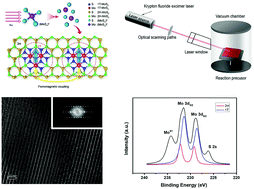Preparation of controllable-thickness 1T@2H-MoS2 thin films by pulsed laser-induced synthesis and the selective separation of the 1T phase
Abstract
Ultrathin 1T@2H-MoS2 films have excellent electronic and optical properties, and are potentially applicable in optics, electronics, energy storage, and sensing technology. However, identification of an efficient method to produce 1T@2H-MoS2 films with controllable thickness is challenging. This study describes the rapid synthesis (5–10 min) of 1T@2H-MoS2 thin films on Si/SiO2 substrates by a novel pulsed laser irradiation method. We verify the photodecomposition reaction model by measuring the UV-Vis absorption spectra of the reactants. The thickness of the synthesized MoS2 film can be controlled by adjusting the concentration of the precursor. Structural characterization confirms that both the 1T and 2H phases exist in the MoS2 film. The 1T phase enhances the conductive behavior of the MoS2 film and induces magnetism. Furthermore, pure 1T-MoS2 can be separated selectively from the MoS2 film under specific operating conditions using pulsed laser-induced synthesis. This approach is suitable for the synthesis of films of MoS2 and other 2D materials, including 1T phase-pure films.



 Please wait while we load your content...
Please wait while we load your content...